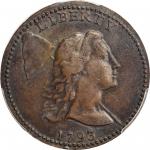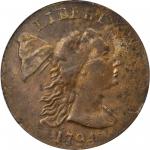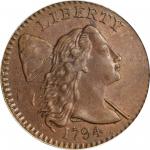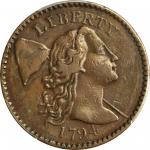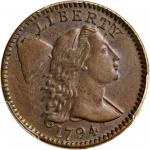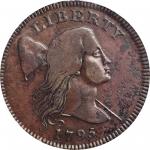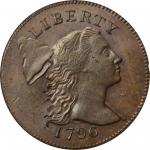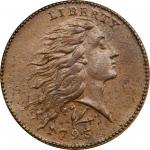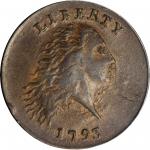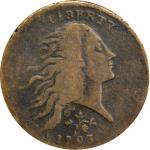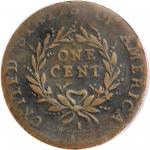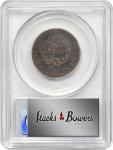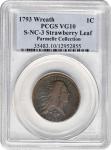1793飘逸长发美分 PCGS VG 10
1793 Flowing Hair Cent. Wreath Reverse. NC-3. Rarity-8-. Strawberry Leaf. VG-10 (PCGS).
Flowing Hair, Wreath Reverse.Obv: A head of Liberty with flowing hair faces right, the word LIBERTY inscribed along the upper border and the date 1793 at the lower border. Instead of the usual sprig with three leaves, there is a spray of three trefoil leaves and a blossom or boll of cotton in the field between the date and the base of the portrait. Rev: A wreath surrounds the denomination ONE CENT, the base of the wreath bound by a ribbon tied into a bow. The legend UNITED STATES OF AMERICA is around the border and another expression of the denomination 1/100 is below.<p><strong>Weight Standard:</strong> 13.48 grams. The weight of this particular example is 13.10 grams.
Approximately 26 to 28 mm.Sheldon NC-3, Breen-15. Obv: The famous Strawberry Leaf variety. The letters in the word LIBERTY along the upper border are even and well formed of small size, essentially identical in scale and character to those found on the obverse of every 1793 Wreath cent variety but for Sheldon-5. Likewise, the date closely resembles that found on other 1793 Wreath cent varieties -- the digit 3 has a delicate bottom curve that appears weak at its lowest point, identical to Sheldon-6 through 11, and the 9 with its short bottom stroke is likewise similar to that digit on other Wreath cents, though most are like the numeral as punched on the obverse of Sheldon-10.
The figure of Liberty also bears strong similarities to that on other 1793 Wreath cent obverse dies, with the three lowest strands of hair long and of nearly equal length, two shorter strands above, another single long strand near the center, and several shorter strands above -- this closely parallels the hair on other 1793 Wreath cents. Indeed, the only notable difference between this obverse die and that of other 1793 Wreath cents is also the precise reason for its fame: a cluster of four small trefoil (three-lobed) leaves above the date and below the truncation of Libertys bust. These leaves closely parallel those found within the wreath on every 1793 Wreath cent variety, though they are not from the same punch as once suggested by Breen. Though they are not precisely identical to the leaves on other Wreath cent reverses, it should be noted that if one looks at any two different trefoils on any single Wreath cent reverse, they are different -- each was individually engraved. This obverse die was also used in the NC-2 pairing, the other Strawberry leaf variety of the 1793 Wreath cent. Rev: This die sets the NC-3 apart from the unique NC-2, which was discovered earlier. David U. Proskey was the first to identify this reverse die, with its distinctive high positioning of the denomination ONE CENT within the wreath. The letters NT in CENT are low, and the ribbon bow is relatively high with a narrow heart shape. NC-3 represents the only known use of this reverse die.<p>Along with the unique NC-2, NC-3 corresponds to the Strawberry Leaf <em>Guide Book</em> variety of the 1793 Wreath cent.
With so few examples known (see below), all of which are in low grade, any deterioration of the dies for the 1793 NC-3 variety cannot be determined.<p><strong>Edge: </strong>Ornamented with bars and a slender vine with leaves. The edge device is the same that the Mint used for the S-5, S-6, S-7, S-10, S-11A, NC-4 and NC-5 varieties, but slightly different from that used for S-8 and S-9.<p><strong>Mintage:</strong> The mintage for the 1793 Wreath cent as an issue is widely accepted to be 63,353 coins. The NC-2 and NC-3 Strawberry Leaf varieties may have been included in the Mints delivery of 8,000 cents on April 28, 1793, almost all of which were from the S-8 die pairing
Estimated Surviving Population for the Die Variety:</strong> Rarity-8-: only three examples of NC-3 are known which, when combined with the unique NC-2, yield just four specimens of the Strawberry Leaf variety.<p><strong>Strike:</strong> The sharpness of this piece is almost incomparable to the other two privately held Strawberry Leaf cents, called "tired and worn out" by Dan Holmes when he owned both examples. The word LIBERTY at the upper obverse border is complete and well defined. Likewise, the date on this specimen is complete. Breen noted in a 1959 article in <em>Empire Topics</em> that this specimen is "the only strawberry leaf coin with all four numerals of the date legible," allowing for the easiest comparison of the very strong similarity between these digits and the potentially identical punches used on other 1793 Wreath cent varieties. Libertys portrait is fully outlined with the eye, nose and mouth all distinct. Most significantly, on no other specimen of the famed Strawberry Leaf cent is the namesake design element so clearly defined, with all four trefoil leaves and the stem fully outlined and clear. Around the top of the obverse, traces of the peripheral beading are present above the letters ERTY in LIBERTY. On the reverse, the top of the letters in the words STATES OF are worn into the border, and the fraction is a bit weak, but all other devices and legends are bold.
Both sides are finely and evenly granular, the devices and peripheries a medium shade of brown that contrasts with the deeper dark brown toning present in the fields. Some scattered microscopic pits are visible on Libertys cheek, but for the most part the devices are smooth and pleasing. Careful examination of the obverse reveals some light blemishes, commensurate with the amount of wear on the coin. Each acts as an identifier that links this coin with its past and future provenance: a tiny nick on the border at 10 oclock, a nick at the juncture of the hair and the high forehead, a nick under the lowest point of the lowest lock, a nick just inside the border near 3 oclock, and a few other tiny marks or abrasions. For the reverse we note a shallow edge bruise over the letter M in AMERICA, as well as a few old vertical scratches near the left ribbon end which are long since toned over.<p><strong>Commentary:</strong> A rare prize that we (American Numismatic Rarities) had the privilege of "finding" again after decades out of the numismatic spotlight. Its history, provenance, and certain other pertinent aspects of this great rarity were discussed by John Kraljevich in our (American Numismatic Rarities) sale of the Frog Run Farm Collection in 2004, and the results of the study are included here; we could not have re-invented the description in a finer manner, and so present much of Johns original cataloging here, as well in the earlier section of this description.
Among the 295 die varieties of early cents numbered by Dr. William Sheldon, in addition to the 53 varieties so rare he deemed them "non-collectible," no variety captures the imagination of early American copper specialists so much as the 1793 Strawberry Leaf cent. Only four specimens are known, all of which are well worn, a fact that no doubt contributes to the aura of mystery and desirability that surrounds them. The long-unknown whereabouts of the finest known specimen, a coin that is numerically twice as fine as the next best example, only adds to that aura and cachet. That finest known example reappeared in our 2004 Frog Run Farm Collection sale, and now, in 2020, bidders will once again have the opportunity to compete for this numismatic treasure in our current offering of the ESM Collection.<p>This coin is the Parmelee 1793 Strawberry Leaf cent, untraced from 1941 to 2004 and, prior to the latter year, not offered publicly since 1890. We were delighted in 2004 to be the first numismatic researchers since Sylvester S. Crosby to examine this coin, and we were honored to present it for public sale to collectors for the first time in 114 years. The obverse of this famous coin has been chosen to illustrate the Strawberry Leaf variety in every edition of the <em>Guide Book</em> since 1946, Ed Frossards 1879 Monograph of United States Cents and Half Cents, issued Between 1793 and 1857, and Sylvester S. Crosbys 1897 <em>The United States Coinage of 1793</em>. The reverse of this coin was likewise illustrated in Crosbys work on 1793s, and both the obverse and reverse are plated in the 2006 edition of <em>United States Large Cents</em> by William C. Noyes.
David U. Proskey was the first to identify the reverse die of the 1793 NC-3 variety, with its distinctive high positioning of ONE CENT, and it was the present coin that served as the discovery specimen. Proskey cataloged this exact example when it was offered as lot 201 in J.W. Scotts sale of October 23 to 24, 1877, when he wrote:<p><em>"1793 Wreath Cent. Stars and stripes on edge with three clover leaves and blossom under the bust. Fair condition, but date and legend perfectly distinct. Unique, both obverse and reverse being from a different die to the one described by S.S. Crosby, Esq."</em><p>Proskey was wrong about this piece being from a different obverse die, but he gets credit for recognizing the difference in the reverse.<p>The edge of this coin, though now unfortunately obscured in the PCGS holder, has been studied and photographed. John Kleeberg, in his important if controversial study on Strawberry Leaf cents in the 1996 ANS Coinage of the Americans Conference proceedings, noted that the edge could be key to answering the ancient question of the origin and purpose of this distinctive design. Eric Newman offered that "accepting the finding that the edge decoration on each strawberry leaf cent differs from the edge decoration of the other strawberry leaf cents and that the edge decoration was cut into each such coin manually and not by Castaing methods" he would posit that the pieces were 19th century forgeries for collectors, perhaps produced by a character like the infamous re-engraver Smith of Ann Street.
Kleeberg noted that he compared the edge of the Strawberry Leaf cents and concluded that, "I think the edge was added by hand." John Kraljevich studied the two privately held specimens of the Strawberry Leaf cent along with a Sheldon-5 Wreath cent graciously provided by Dan Holmes at the April 2004 EAC show, before the present coin was rediscovered. When placed atop each other, then twisted and turned like so many facets of a Rubiks Cube, the edges of both Strawberry Leaf cents and the 1793 S-5 lined up precisely -- a fact that Mr. Holmes was the first to discover. The edge die used to impress the device on the Strawberry Leaf cents on the Castaing edging machine was identical, i.e. the exact same edge die, as the one that edged that particular S-5 -- and probably other Wreath cents as well. This proves that the planchets were produced at the U.S. Mint and strikes down theories of extralegal origin, unless a farfetched theory of the removal of blank planchets from the Mint were to be constructed. As per a request of Eric Newman, John Kraljevich had likewise scrutinized the strawberry leaf cluster on the present coin and saw absolutely no suggestions of disturbance, re-engraving, or other tomfoolery.
The weights of the known Strawberry Leaf cents are all within an appropriately close range of the Mint standard of 13.48 grams. Kleeberg calls himself a "partisan" of the theory that the 1793 Strawberry Leaf cents are contemporary counterfeits. Based upon the ease of making cast counterfeits rather than creating three new and distinctive steel dies, such a theory does not pass the common sense test for us. When further considering the fact that most circulating counterfeits duplicate worn coins (thus making them easier to pass), yet these cents are produced to a weight standard that was abandoned for a lighter one in mid-1795, the scenario becomes even less likely. The new discovery that these cents were produced with the precise same edge die as other collectible 1793 Wreath cent varieties should firmly place this and other theories in the past and confirm this enigmatic issue as an unusual product of the U.S. Mint.<p>"But why strawberry leaves (or clover, or laurel, etc.)?" a numismatist might wonder. The first year of coining cents for circulation at the Mint was clearly a series of trials and errors: the weight standard was lowered in January 1793, before a single coin could be struck for circulation at the original statutory weight. Chain cents were struck, then the designs were changed to the more attractive Wreath design, before finally switching gears to use Joseph Wrights masterful Liberty Cap motif.
Several different edge motifs were tried: a lettered edge with one leaf, the same lettering followed by two leaves, as well as the "vine and bars" edge that was used on the Chain cents and most Wreath cent varieties, including the Strawberry Leaf pieces. Clearly the Mint was not placing a high premium on consistency of design. We are tempted to suggest that the Strawberry Leaf design was merely the result of a bit of artistic license by a Mint engraver, or it could have been the initial design for a type whose later evolution would include only olive leaves as obverse decoration. Undoubtedly the difference in design is more noteworthy to modern numismatists than to those who produced or used cents in Philadelphia in 1793. From the level of wear present on the four known specimens, it is clear that they were produced to circulate and succeeded in their assigned role. As one of the most celebrated rarities of the 19th century -- a coin which evoked enough passion to cause a brawl on an auction room floor (see more below) -- it is a wonder the Strawberry Leaf is not as passionately pursued today. One of the great rarities offered at the Parmelee sale was a Class I 1804 dollar. That piece sold for $570, about five times what this exact coin brought in the same sale. Over the 130 years since the Parmelee sale, there have been dozens of appearances of an 1804 dollar at auction. While an 1804 dollar is an antedated fantasy, its fame grew at every auction appearance. The Strawberry Leaf cents have been on the market far fewer times and exposed much less to the greater collecting populace in the 20th and early 21st centuries.<p>The history of this specimen is nearly as fascinating as the Strawberry Leaf variety itself.
After its discovery by Proskey as the first with the high ONE CENT reverse, the piece was purchased at auction by famous Boston bean baker Lorin G. Parmelee (for more on Parmelee, see below). While Parmelee enjoyed "horse trading," this piece was not sold until his entire cabinet was consigned to auction in 1890. It was purchased by another Bostonian, a physician named Dr. Thomas Hall who is best known for his pioneering 1892 work on varieties of Connecticut coppers. The Hall monograph used a system that was followed by Henry Miller and remains the taxonomic standard for Connecticut coppers today. After his death in May 1909, the entire Hall cabinet was purchased intact by Chicago brewing magnate Virgil Brand, including hundreds of colonial coins, large cents, and medals. At the time, Brand had already been collecting for two decades and had developed an insatiable appetite for numismatics, a lifelong passion that is well-described in Dave Bowers book<em> Virgil Brand: A Man and His Era</em>. After his death in 1926, Brand left behind a vast estate including tens of thousands of numismatic items, a holding that was left to his brothers Horace and Armin at the time of his death and was not fully dispersed until the 1980s. Even as early as the 1930s, portions of the collection were consigned to various leading dealers, including St. Louis dealer Burdette G. Johnson. Johnson was the proprietor of St. Louis Stamp and Coin Company and served as one of the largest wholesale dealers in the nation at the time, often handling multiple specimens of great rarities -- most memorably, all five specimens of the 1913 Liberty Head nickel from the "Colonel" E.H.R. Green estate. In 1941, Armin Brand consigned 17 1793 cents to Johnson, all of which were Condition Census specimens, and among their number were specimens of all five "NC" varieties of the year then known! Two of those "NCs," as Dr. Sheldon would call them a few years later, are still unique and another (1793 NC-1) was unique at the time and is still 44 points finer than the only other known example. It is telling that, despite the great rarities and the number of superb Mint State 1793 Wreath and Chain cents included, the only piece Johnson was able to sell within one year of the consignment was the present specimen, the finest 1793 Strawberry Leaf cent.
It was selected before the finest Sheldon-1, the finest NC-1, the second finest Sheldon-4 (considered better than the Eliasberg piece), the finest Sheldon-7, the finest Sheldon-9, and a number of other incredible 1793 cents. James Kelly, a dealer who had a long-standing professional relationship with Johnson, took the piece on consignment from Johnson in May 1941 for $2,500 -- an incredible sum at the time -- and quietly sold it the same year to a nearly unknown collector from Maine, Roscoe E. Staples, for $2,750. In the same era, both the Childs and Dexter 1804 Class I dollars sold in the $4,000 to $5,000 range, an indication of just what $2,750 could buy (like, for instance, a pretty nice house). A few months later, when a new Strawberry Leaf cent was discovered (the AG-3 Starr NC-3), it was offered at $2,500 but found no buyers; it sold for $1,200 at auction in 1950. The Staples family held the coin until it was consigned to our 2004 sale, but its original purchaser enjoyed the piece for all too short a period of time.<p>Roscoe Staples, a successful businessman, joined the Maine National Guard in 1934 as a second lieutenant and was promoted to first lieutenant in 1940, then captain in 1941 as a great world war approached. As a member of the 103rd Infantry, Staples embarked for the Pacific theater in fall 1942 after having already been away from his Maine home for a year - it appears by the time he purchased this coin from James Kelly he had already left for training elsewhere in the United States. In early 1943, Staples regiment was part of a force that left for Guadalcanal and received further training in jungle warfare on the nearby islands. A few months later, in the summer of 1943, orders came down the chain of command that Staples was to help command the regiment as it worked to secure the Munda airfield in the Solomon Islands, then under the control of the Japanese. A young naval officer from nearby Massachusetts, John F. Kennedy, captained a PT boat off the coast of Munda (now New Georgia) to patrol for Japanese destroyers during the same action. Kennedy was famously injured when a Japanese vessel collided with his <em>PT-109</em> off the coast on the night of August 1, 1943. A few miles away the next day, while his troops were actively engaged in taking the Munda airfield from the remaining Japanese forces, then-Major Staples was shot and killed by a Japanese sniper who paid for his actions with his own life. Staples was posthumously awarded the Silver Star for bravery, and he was noted for being "a brilliant officer who had the respect of his men and his superiors." The airfield was secured on August 5, 1943, after a month of incredible difficulty. His citation noted that although his duties as a regimental S-3 did not require him to expose himself to enemy fire at the front lines, Major Staples repeatedly visited the companies at forward areas to check the progress of operations and to make suggestions to company commanders in an effort to save lives and to bring the battle to a decisive finish. Major Staples courage and devotion to duty were an inspiration to the troops and contributed immeasurably to the success of operations. While World War Two and a 1793 Strawberry Leaf cent would seem to have little in common, we feel it is important to recognize the character and contributions of a little-known past owner of this famous coin. While Proskey, Parmelee, Johnson, and others are well-known to numismatists, and many rare coins can be traced to their hands, Staples most notable contributions clearly came outside of the realm of numismatics.
After Staples death, the coin remained with his family until sold in our 2004 Frog Run Farm Collection sale. We at Stacks Bowers Galleries could not be more proud to once again offer this great rarity, now part of the fabulous ESM Collection of Large Cents, in which it is a leading highlight. The next owner will themselves become the next chapter, joining Proskey, Parmelee, Hall, Brand, Staples and the ESM collector as leading characters in this remarkable story and add his or her name to this historic provenance. There is no need to cite the great specialized large cent cabinets that have lacked a specimen of this rarity -- nearly all have -- or the great collectors of the last 150 years who have never owned one, as most never did. With 25% of the population permanently off the market, it is difficult for us to foresee another opportunity to purchase a specimen in the upcoming decade or more.<p>As noted above, the most famous (though perhaps not the most recent) case of numismatic fisticuffs revolved around a specimen of this precise variety. As described in Carl Carlsons superb article for the November 1978 edition of <em>The Numismatist</em> titled "Strawberry Leaves and Shiners," the ANS example of the NC-3 was the root of a physical struggle between two of the most respected dealers of their era: Ed Frossard and Lyman Low. When the Merritt-Haines-ANS specimen was presented for public sale in December 1894 as part of Frossards 130th auction, for some reason Lyman Low called Frossard a "liar," though what he lied about is not recorded. Two later recollections of the scene have survived and both describe how Frossard and Low ended up rolling around on the floor until pulled apart by Harlan P. Smith, who lost a diamond stickpin in the fracas. Augustus G. Heaton noted the "two numismatic sages were soon mixed up on a dusty floor in a manner that would have made football adversaries envious of their combative qualities until, in a badly circulated condition, they were dragged apart by dismayed spectators." Charles Steigerwalt, who sold the piece offered today to Dr. Thomas Hall after the Parmelee sale, noted in a 1911 piece that the Parmelee specimen "described as good was really fine and the best known" and went on in the sale article to state that Frossard and Low "rolled around on the floor of the auction room, trying to kick each other." Notably, Carlson chose to illustrate his article with a photo of this exact specimen, taken from the 1897 Crosby plate.<p>As previously stated, only four Strawberry Leaf cents are known, including three examples of NC-3 and the unique NC-2.
First identified by David U. Proskey. Ex J.W. Scott & Co.s sale of October 1877, lot 201, where it realized $77.50; purchased on the floor by H.G. Sampson, acting for Lorin G. Parmelee, outbidding Joseph N.T. Levicks $75 commission for Sylvester S. Crosby; New York Stamp and Coin Co.s sale of the Lorin G. Parmelee Collection, June 1890, lot 671, where it realized $79; purchased by Charles Steigerwalt and resold to Dr. Thomas Hall in October 1890 for $90; sold as part of the intact Hall Collection to Virgil Brand on September 7, 1909; Brand estate; consigned by Armin Brand to Burdette G. Johnson along with 16 other important 1793 cents on February 7, 1941; James Kelly, May 1941, for $2,500; Roscoe E. Staples, for $2,750; Staples family; our (American Numismatic Rarities) Frog Run Farm Collection sale, December 2004, lot 130; our (Stacks) Orlando Sale of January 2009, lot 51. <em><strong>The present example</strong></em>, the plate coin for the variety in the 2006 edition of the Noyes large cent reference; the obverse has been used to illustrate the Strawberry Leaf variety in every edition of the <em>Guide Book</em> since 1946. Previously certified Fine-12 BN by NGC (insert #1827897-001).<p>2 - <strong>NC-3. PCGS Good-4.</strong> Ex William Rabin, who discovered the coin in Philadelphia and offered it for sale in the September 1941 issue of <em>The Numismatist</em>, page 736; James Kellys sale of May 1949, lot 1044; Floyd Tallmadge Starr; our (Stacks) sale of the Floyd T. Starr Collection of United States Large Cents and Half Cents, June 1984, lot 7; Isaac Tatnall Starr, June 12, 1989; R.E. "Ted" Naftzger, Jr., February 23, 1992; Eric Streiner; Jay Parrino, October 7, 1995; Anthony Terranova, October 16, 1994; Dan Holmes; Ira & Larry Goldbergs sale of the Dan Holmes Collection, Part I, September 2009, lot 8; Adam Mervis; Heritages sale of the Adam Mervis Large Cent Collection, January 2014 FUN Signature Auction, lot 2420. The plate coin for the variety in the 1991 edition of the Noyes large cent reference.<p>3 - <strong>NC-3. About Good.</strong>
Ex George W. Merritt; Ed Frossards sale of January 1879, lot 90; Ferguson Haines; W. Elliott Woodwards Sale #32, October 1880, lot 189; H.G. Sampson; Ferguson Haines; S.H. and H. Chapmans sale of October 1888, lot 846, withdrawn; Ferguson Haines; Ed Frossards Sale #130, December 1894, lot 700; J. Sanford Saltus, May 16, 1906; American Numismatic Society Collection.<p>4 - <strong>NC-2. PCGS Fair-2.</strong> Ex John Meader, who acquired the coin from circulation in 1845 (according to Del Bland in his census published in Walter Breens large cent encyclopedia), December 1868; Richard B. Winsor; S.H. & H. Chapmans sale of the Richard B. Winsor Collection, December 1895, lot 823; Sylvester S. Crosby, April 1896; Dr. Thomas Hall, September 7, 1909; Virgil Brand; Brand estate, February 7, 1941; Burdette G. Johnson, September 12, 1941; James Kelly, 1941; Numismatic Gallerys sale of the Charles M. Williams Collection, November 1950, lot 6; Floyd Tallmadge Starr; our (Stacks) sale of the Floyd T. Starr Collection of United States Large Cents and Half Cents, June 1984, lot 6; R.E. "Ted" Naftzger, Jr., February 23, 1992; Eric Streiner; Jay Parrino, October 7, 1995; Anthony Terranova, October 16, 1995; Dan Holmes; Ira & Larry Goldbergs sale of the Dan Holmes Collection, Part I, October 2009, lot 7; Adam Mervis; Heritages sale of the Adam Mervis Large Cent Collection; January 2014 FUN Signature Auction, lot 2419.PCGS# 35483. NGC ID: 223H.From the ESM Collection. Earlier ex J.W. Scott & Co.s sale of October 1877, lot 201, where it realized $77.50; purchased on the floor by H.G. Sampson, acting for Lorin G. Parmelee, outbidding Joseph N.T. Levicks $75 commission for Sylvester S. Crosby; New York Stamp and Coin Co.s sale of the Lorin G. Parmelee Collection, June 1890, lot 671, where it realized $79; purchased by Charles Steigerwalt and resold to Dr. Thomas Hall in October 1890 for $90; sold as part of the intact Hall Collection to Virgil Brand on September 7, 1909; Brand estate; consigned by Armin Brand to Burdette G. Johnson along with 16 other important 1793 cents on February 7, 1941; James Kelly, May 1941, for $2,500; Roscoe E. Staples, for $2,750; Staples family; our (American Numismatic Rarities) Frog Run Farm Collection sale, December 2004, lot 130; our (Stacks) Orlando Sale of January 2009, lot 51. The plate coin for the variety in the 2006 edition of the Noyes large cent reference; the obverse has been used to illustrate the Strawberry Leaf variety in every edition of the <em>Guide Book</em> since 1946. Previously certified Fine-12 BN by NGC, insert #1827897-001 is included with this lot.

